CJAD IN MONTREAL: RICHARD AND KEN CONNORS TALK 30 YEARS OF BATMAN!
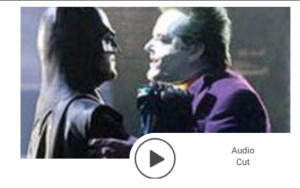 Richard and CJAD host Ken Connors discuss the 30th anniversary of caped crusading with a look at the 1989 “Batman.”
Richard and CJAD host Ken Connors discuss the 30th anniversary of caped crusading with a look at the 1989 “Batman.”
Watch the whole thing HERE!
 Richard and CJAD host Ken Connors discuss the 30th anniversary of caped crusading with a look at the 1989 “Batman.”
Richard and CJAD host Ken Connors discuss the 30th anniversary of caped crusading with a look at the 1989 “Batman.”
Watch the whole thing HERE!
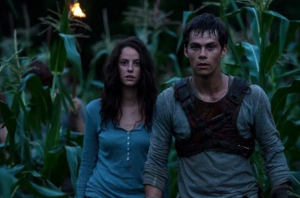 Giant labyrinthine puzzles are almost as old as mankind: Prehistoric mazes were built as traps for malevolent spirits, while in medieval times the labyrinth represented a path to God. But recently, the idea of people struggling through a complicated network of paths has made for some striking visuals in movies.
Giant labyrinthine puzzles are almost as old as mankind: Prehistoric mazes were built as traps for malevolent spirits, while in medieval times the labyrinth represented a path to God. But recently, the idea of people struggling through a complicated network of paths has made for some striking visuals in movies.
This weekend, The Maze Runner sets much of its action inside a gigantic maze where frightening mechanical monsters called Grievers wander, tormenting Thomas (Dylan O’Brien) as he navigates the maze to pick up clues that help him piece together memories of his past. The sci-fi story is just the latest to feature a maze as a major plot point, but just as Labyrinth’s Sarah (Jennifer Connelly) is warned, “nothing is as it seems” in these movie puzzles.
Remember Harry Potter and the Goblet of Fire? Like Thomas in The Maze Runner, the boy wizard has to make it through a maze (in this instance to find the Triwizard Cup), but instead of fighting magical creatures, this hedge maze is magical; shape shifting to make the journey extra difficult. The 1972 horror film Tales from the Crypt contained an even more sinister maze.
Made up of five stories, the film culminated with the tale of a labyrinth told with razor-sharp wit. Set in a home for the blind, the patients get even with the institute’s cruel director by placing him in the centre of a maze of narrow corridors lined with razor blades. It’s a cutting edge story, that, according to besthorrormovies.com “rivals the ‘death traps’ of Saw and ‘tortures’ of Hostel while only showing a single small cut of the flesh.”
In The Shining, the axe-wielding father Jack Torrance (Jack Nicholson) chases his son Danny (Danny Lloyd) through the Overlook Hotel’s hedge maze. The quick-thinking boy escapes by retracing his steps, confusing his maniacal dad. The documentary Room 237 offers up a number of interpretations of what the maze and Danny’s escape represents. One theory suggests it reflects Greek hero Theseus’ slaying of the Minotaur and escape from the labyrinth, while another speculates it’s a metaphor for conquering repression. Whatever the subtext, it remains one of director Stanley Kubrick’s most tense scenes.
And finally, Francis Ford Coppola’s version of Dracula sees Lucy (Sadie Frost) sleepwalking through a garden maze, chased by Dracula (Gary Oldman) in wolfman form while Pan’s Labyrinth features a maze as a place of safety for Ofelia (Ivana Baquero) to evade her attacker.
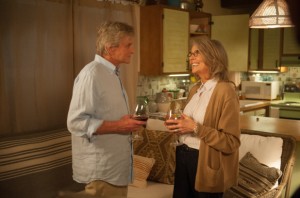 By Richard Crouse – Metro Canada
By Richard Crouse – Metro Canada
Diane Keaton’s latest film, the romance And So It Goes, brings the star back to her roots.
As a beginner, long before she won an Academy Award for Annie Hall, or starred in the controversial Looking for Mr. Goodbar or inspired romantic rivalry between her Reds leading men, Warren Beatty and Jack Nicholson, Keaton dreamed of being a singer.
“I had a fantasy of being a nightclub singer that I carried through even into my early 20s,” she says.
“I sang a couple of gigs, as they call them, but I was not very good. I began to understand that I was not going to be a singer. I’ve always loved to sing but I’m aware of the limitations of my voice. It was always a disappointing voice. I took singing lessons for years, but it was a very small voice. It’s worse than it ever was. It’s smaller than ever. But I have this love of it. I love music. I love singing ballads and sad songs, it’s just so much fun.”
And sing she does in the new film, a romance co-starring Michael Douglas — “He couldn’t be any more charming,” she says — about Leah, a woman who gets a second chance at a career and love.
“I never thought I’d ever sing again. I had some songs intermittently in some movies but to have it come up again and have the possibility of singing four songs and one song all the way through was a dream come true.”
Keaton describes Leah, a lounge singer who bursts into tears at the mere thought of her late husband, as a woman, “who has had a lovely life but has lost the love of her life. She’s my age, in her late 60s.”
The 68-year-old Oscar winner says playing Leah was “a joy,” but adds, “getting old is a great levelling experience. You really do see the truth, which is that your expression and your goals don’t really mean much in the grand scheme of things.
“With that in mind you start seeing life in a different way. You don’t see it so much as the goals for the future; it’s just now. You live in the moment, in the present. This is what you have.
“So I really feel you’re more grateful, you’re more filled with awe, you’re more amazed because it is a huge, giant question mark this life we live in.
“It’s a huge gift and you need to see yourself for what you are and appreciate what you have while you have it now.”
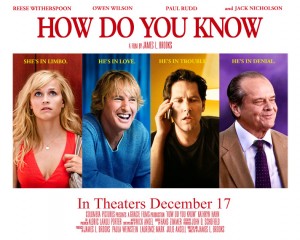 Normally I’m not a stickler for punctuation. I’ve been known to drop a comma or two and throw in an inappropriate semi-colon here and there, but the lack of a question mark at the end of the title “How Do You Know” really bugs me. Does director James L. Brooks not have Spelling and Grammar check on his computer? Was star Reese Witherspoon sick the day they taught question mark use in school? What could possibly be the excuse for such an egregious and flagrant abuse of the English language?
Normally I’m not a stickler for punctuation. I’ve been known to drop a comma or two and throw in an inappropriate semi-colon here and there, but the lack of a question mark at the end of the title “How Do You Know” really bugs me. Does director James L. Brooks not have Spelling and Grammar check on his computer? Was star Reese Witherspoon sick the day they taught question mark use in school? What could possibly be the excuse for such an egregious and flagrant abuse of the English language?
In the film Witherspoon is a aging pro athlete at the end of her career. For twelve years she was the star of the USA Woman’s Softball Team, but when she gets cut she finds herself adrift in life. Caught in a love triangle between two men—Paul Rudd and Owen Wilson—who love her for completely different reasons, she must choose one of them but first has to learn how to know when she’s in love.
Even though I was in a bad mood because of all this question mark business, “How Do You Know” still managed to mostly win me over not because it is great, because it isn’t—it rises to the level of good, but not much further than that—but because of its appealing cast.
Witherspoon has been absent from the big screen for two years—her voice work in “Monsters vs. Aliens” doesn’t count—and in that time many have tried and failed to find the rom com sparkle she so effortlessly brings to this movie.
Rudd, as the slightly awkward suitor being investigated for fraud, brings the funny and the mushy and Owen Wilson’s immature pro-ball player is a very funny throwback to his “Zoolander” days.
A big surprise is Kathryn Hahn, as Rudd’s empathic assistant. Best known for roles on television in shows like “Crossing Jordan” and “Hung,” she’s a live wire who brings much to the movie, including its most moving scene. A bigger surprise is Jack Nicholson as Rudd’s devious father. He’s worked with Brooks before, earning two Academy Awards in the process, but here he’s wasted in a role that gives him little to do. For the first time in years Nicholson barely registers on screen.
“How Do You Know” suffers from a weird rhythm, unnecessary minutes in the third act and a major unresolved plot point but is rescued by the enthusiasm of its cast.
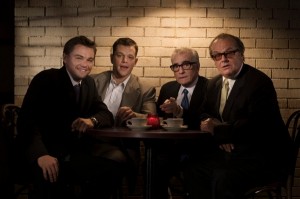 I admired Martin Scorsese’s last two movies, Gangs of New York and The Aviator, but I didn’t love them, and Scorsese is the kind of filmmaker who should inspire fanatical praise. The last two were handsome, big-budget epics but it felt like he was making movies to please Academy voters and not himself. The Departed is a departure from those sleek studio efforts, and places the director firmly back where he belongs, on the mean streets surrounded by gangsters, duplicity and violence.
I admired Martin Scorsese’s last two movies, Gangs of New York and The Aviator, but I didn’t love them, and Scorsese is the kind of filmmaker who should inspire fanatical praise. The last two were handsome, big-budget epics but it felt like he was making movies to please Academy voters and not himself. The Departed is a departure from those sleek studio efforts, and places the director firmly back where he belongs, on the mean streets surrounded by gangsters, duplicity and violence.
Based on a Hong Kong film called Mo-gaan-do (titled Infernal Affairs in North America) The Departed, relocates to Boston and stylishly tells the story of two men on opposite sides of the law. Both are cops, one deep undercover in the organization of mob boss Frank Costello (Jack Nicholson), the other an ambitious state trooper who appears to be on the straight and narrow, but is actually an employee of Costello’s. Both men, played by Leonardo DiCaprio and Matt Damon respectively, are tormented by their duplicitous lives, feeling trapped between the truth and lies, but neither has a way out of the situation. DiCaprio is so far undercover that officially he doesn’t exist, and Damon’s character owes a huge dept of gratitude to Costello. Their lives intersect both professionally—as they play cat and mouse with one another—and personally as they unwittingly become involved with the same woman, a beautiful therapist played by newcomer Vera Farmiga.
Scorsese skillfully tells this story about loyalty and men who lead dark, dangerous lives, infusing each frame of the film with excitement. He has created an unpredictable atmosphere, where the threat of trouble hangs over every scene. Not since 1995’s Casino has he so effectively embraced the down-and-dirty world of crime. The film is a study of contradictions, both in character and style—Scorsese mixes fluid camera work with hard-edged editing; his script is both darkly funny and brutally violent.
The movie’s large ensemble cast of Hollywood A-listers do great work. The youngest members of the above-the-title cast, DiCaprio and Damon, each set the bar very high. This may be DiCaprio’s first truly adult role, a man who can’t trust anyone and who battles his jangled nerves to do the right thing. Damon plays off his clean-cut image, expanding on his recent work in Syrianna and the Bourne movies, to present a good-guy façade that is being eroded by paranoia.
The rest of the cast, Ray Winstone, Martin Sheen, Mark Walhberg (as the foul-mouthed Dignan) are stellar, but if there are two performances that look Oscar bound they are Jack Nicholson and Alec Baldwin.
Baldwin plays Ellerby, a task force head out to get Costello with gusto. The character is a mix of steely-eyed determination and goofy comedic relief, and Scorsese keeps him in check, allowing to walk to the edge of the cliff without ever jumping over into overacting. It’s a fine line and Baldwin walks it expertly.
In a film packed with great performances—it’s as if everyone was putting in extra effort for Scorsese—Jack Nicholson still manages to steal the show. Costello is his King Lear, a tyrant on the edge of madness, but with Nicholson’s burning eyes. Closing in on 70 years old he is still vital, still scary and still capable of blowing younger, prettier actors off the screen. There is a reason why some people are legends and in The Departed we are reminded once again why Nicholson is acting royalty.
The Departed finds Scorsese in top form, and is the coolest and best movie so far this year.
 The Bucket List is the story of two terminally ill men played by Jack Nicholson and Morgan Freeman who, faced with death, form an unlikely friendship and discover what it’s really like to be alive. It’s sort of The Grim Reaper meets The Odd Couple.
The Bucket List is the story of two terminally ill men played by Jack Nicholson and Morgan Freeman who, faced with death, form an unlikely friendship and discover what it’s really like to be alive. It’s sort of The Grim Reaper meets The Odd Couple.
These guys are great actors, but let’s face it, neither of them are doing anything we haven’t seen them do a million times before. Freeman does the narration; Nicholson plays the wacky guy who hides emotional pain under a flamboyant front. They don’t embarrass themselves here, they’re both too good for that, but they don’t do anything interesting or fresh either.
In the end it’s a predictable movie that seems to try and manipulate the viewer into bursting into tears when really he or she might only be trying to suppress yawns.